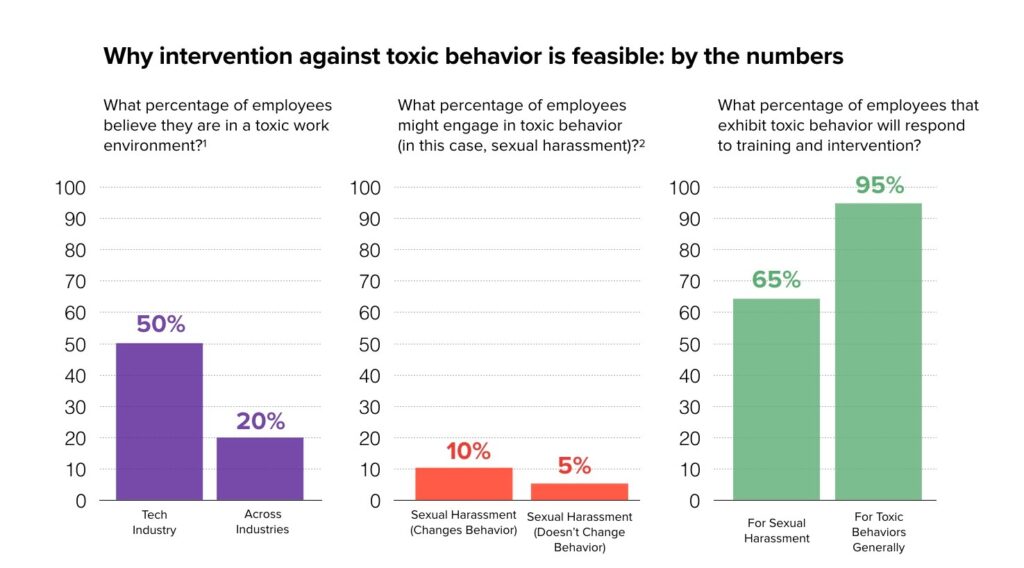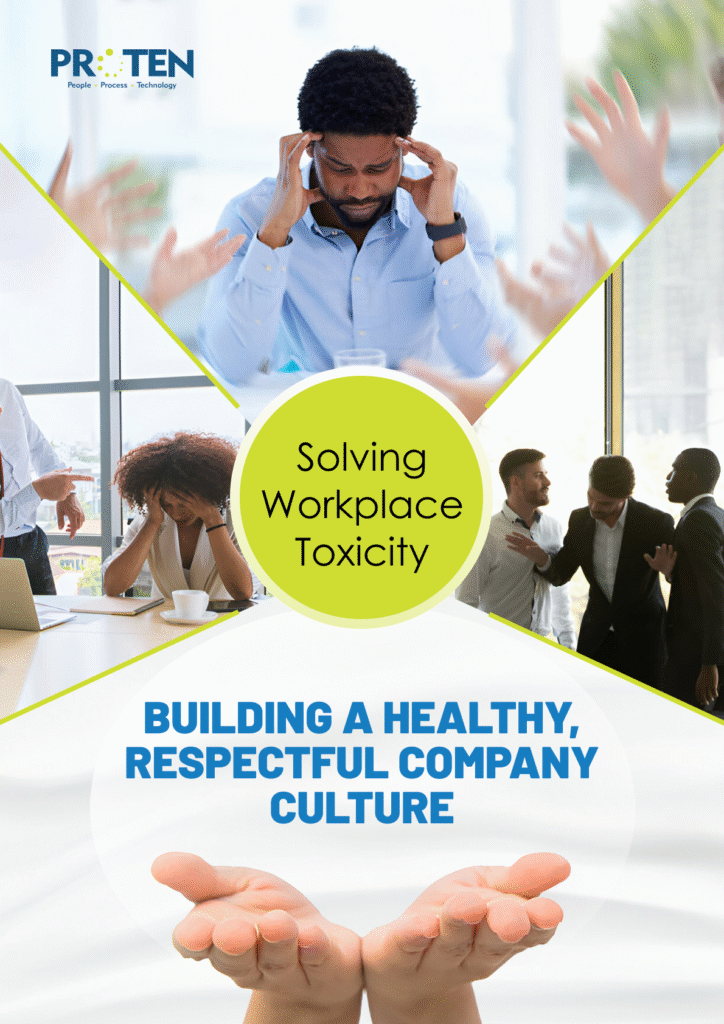
In a recent report on workplace harassment and bullying, Jobberman found that 35% of Nigerian employees have experienced harassment in the workplace. Similarly, another study by Careerjunction found that 69% of employees considered quitting their jobs because of work-related stress. These surveys and many others like them highlight the problem of workplace toxicity and the need to take steps to address it.
Workplace toxicity poses a significant threat to organisational success, employee well-being, and overall productivity. Just as humans fall ill, societies and organisations do, too. Toxicity is a symptom of a sick and unhealthy workplace culture that needs to be treated. This report explores the root causes of workplace toxicity, its detrimental impacts on individuals and companies, and provides a comprehensive, actionable framework for fostering a healthy, respectful company culture.
Understanding Workplace Toxicity
What is Workplace Toxicity?
Workplace toxicity refers to an environment characterized by harmful policies, negative attitudes and behaviours, and practices that perpetuate conflicts and undermine employee morale, collaboration, and productivity. Common examples include:
- Bullying and harassment: Workplace bullying is often observed in the abuse of power. When colleagues and managers exhibit behaviours intended to degrade, offend, intimidate, threaten or humiliate others, this is a culture rife with toxicity.
Oftentimes, bullying is accompanied by harassment. This often takes the form of mean and derogatory jokes, pressures for dates and sexual favours, or insulting comments and slurs directed at people based on their ethnicity, religion, gender, or disabilities.
- Favouritism and discrimination: According to a study from INTOO and Workplace Intelligence, 46% of employees said they aren’t getting a fair shot due to favouritism from leadership. Healthy workplaces are built on merit and competence. When workplace culture becomes toxic, unqualified employees begin to get ahead while competent people are maligned because merit is no longer the yardstick for advancement.
Favouritism is an unfair and unethical practice because it elevates one employee over others for reasons other than merit. Discriminating against people based on their immutable characteristics will always produce workplace toxicity.
- Poor communication and lack of transparency: When people are starved of information, they resort to rumours, side talk, gossip, and innuendos. Toxic workplaces are characterised by poor communication, mixed messages, unclear expectations, and lack of transparency.
In a healthy workplace, it is important to communicate clearly to ensure that there is no disconnect between what is said and what is understood.
- High levels of stress and burnout: Sometimes, toxicity in the workplace is physical, not psychological. Excessive workload and a burnout culture are common signs of a toxic workplace.
Working long hours, being too busy to eat, and sacrificing personal time are not a badge of honour. When employees constantly have to work late into the night, all weekend, and still come away feeling like they are not doing enough, that is a marker of toxicity. Relentless pressure to meet unrealistic demands is a sign of a toxic workplace.
The Impact of Toxic Work Environments

Source: Massivue
- Employee Well-Being: According to data from INTOO and Workplace Intelligence earlier referenced, more than 35% of employees said they will accept lower pay for a job free of workplace toxicity.
A toxic environment takes its toll on the mental and physical well-being of employees leading to increased stress, anxiety, depression, and burnout. When people feel like they are always walking on eggshells for fear of punishment, or are reluctant to share their thoughts and ideas for fear of ridicule, it affects their sense of well-being in the workplace.
- Turnover Rates: Higher attrition rates impact the organisation negatively leading to increased recruitment and training costs. When employees are constantly leaving your organisation, that is a huge red flag signifying deep-seated cultural issues that require attention.
- Productivity: A healthy workplace is necessary for high-performing and productive teams. Toxicity in the workplace reduces efficiency and innovation as employees are more likely to withhold ideas, feedback, and information which are critical to organisational growth.
- Reputation: Employees who leave a toxic workplace tend to leave bad reviews of the company on public platforms and job sites. This is a source of damage to the company’s brand and creates difficulty attracting top talent.
- Legal Risks: In the case where discrimination against employees violates their legal rights and protections under the law, the organisation can become legally vulnerable. Toxic workplaces can open the door to potential lawsuits arising from harassment or discrimination claims.
Root Causes of Workplace Toxicity

Source: TalentLMS and Culture Amp
- Leadership Issues: Sometimes, the culture of toxicity flows from the top of the organisational hierarchy. This can lead to the creation of policies and procedures that perpetuate toxicity such as lack of accountability, poor management practices, or abusive leadership.
- Cultural Misalignment: Other times, procedures and policies are not the source of workplace toxicity but a disconnect between stated values and actual practices.
- Lack of Clear Policies: The absence of guidelines on acceptable behaviours and consequences for violations can lead to toxicity in the workplace. Organisations need to have ethics policies where boundaries and expectations of workplace interactions are clearly stated.
- High-Pressure Environments: High pressure due to unrealistic demands and expectations often creates a breeding ground for workplace toxicity as employees are always trying to pass the buck, shift blame, or throw each other under the bus.
Building a Healthy, Respectful Company Culture
1. Leadership Accountability and Training
- Regular Training: Train your leaders on values and ethical standards and equip them with skills in emotional intelligence, conflict resolution, and inclusive leadership.
- Accountability Mechanisms: Core values are important to organisational culture, so ensure that they are upheld by everyone, especially leaders. This can be done by establishing metrics to evaluate leadership effectiveness and their adherence to cultural values.
- Modelling Behaviour: Leadership is primarily by example. It is important to ensure leaders exemplify respectful, ethical behaviour.
2. Clear Policies and Reporting Mechanisms
- Comprehensive Policies: Most problems including workplace toxicity are rooted in ignorance or lack of clarity. Define acceptable and unacceptable behaviours, with clear consequences for violations.
- Anonymous Reporting Channels: Feedback channels are important for reporting harassment and abuse. Provide employees with safe, confidential ways to report issues.
- Swift Action: Create a culture that ensures that complaints are investigated and treated. Ensure timely inquiry into and resolution of reported incidents.
3. Fostering Open Communication
- Regular Feedback Loops: Conduct surveys, town halls, and one-on-one check-ins to gauge employee sentiment.
- Transparent Decision-Making: Employees are important stakeholders in any organisation and should not be discounted or ignored. Share organizational decisions and the rationale behind them.
- Active Listening: Pay attention to your staff and demonstrate that employee concerns are heard and addressed.
4. Prioritizing Employee Well-Being
- Work-Life Balance: If burnout is observed to be a prevalent issue, effort should be geared towards reassessing workloads. Encourage flexible work arrangements and reasonable workloads.
- Mental Health Support: Offer resources such as counselling services or wellness programs.
- Recognition Programs: Celebrate achievements to boost morale and appreciation. Positive reinforcement motivates individuals to be more productive and form meaningful bonds with each other and the organisation.
Implementation Framework

Source: FAMA
Phase 1: Assessment and Planning
- Conduct a workplace culture audit.
- Identify specific areas of concern and set measurable goals.
Phase 2: Policy and Program Development
- Draft and communicate clear policies.
- Develop training programs and establish support resources.
Phase 3: Execution and Engagement
- Launch initiatives with visible leadership support.
- Involve employees in culture-building activities.
Phase 4: Monitoring and Iteration
- Regularly review progress through surveys and feedback.
- Adjust strategies based on outcomes and employee input.
Conclusion
According to an APA work survey, 92% of survey respondents indicated that it is very or somewhat important to them that an organisation values their emotional and psychological well-being. Similarly, in a report by McKinsey & Company, it was discovered that more than 60% of negative workplace outcomes are due to toxic workplace behaviour. This highlights the impact of workplace toxicity on organisational productivity and the importance of addressing this pressing and prevalent issue.
However, addressing workplace toxicity is not a one-time effort but an ongoing commitment to building a culture of respect, transparency, camaraderie, and well-being. By investing in leadership, clear policies, open communication, and employee support, organizations can transform toxic environments into thriving, productive workplaces. The result is a win-win scenario: happier employees and stronger business outcomes.
How Proten can help
Organizations ready to embark on this journey can begin by engaging the services of a trusted HR advisory partner such as Proten International.
In some cases, addressing the issue of toxicity in the workplace will require engaging the services of experts in conducting assessments to identify root causes, developing a tailored and comprehensive plan to solve the problem, and following up on the implementation closely to ensure the desired outcomes are achieved.
We are committed to helping organisations develop great and thriving workplace cultures. Together, we can create workplaces where everyone feels valued and empowered to contribute their best.

